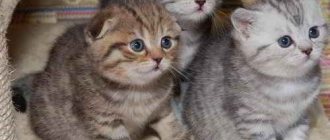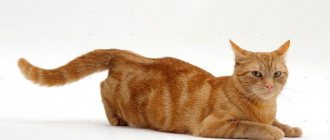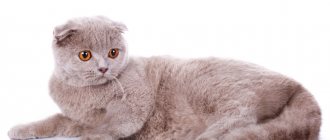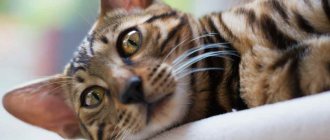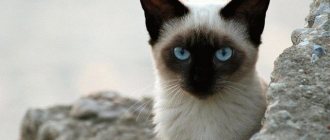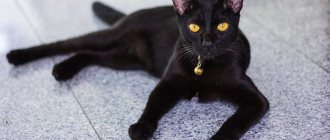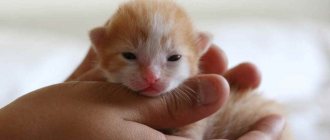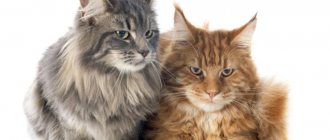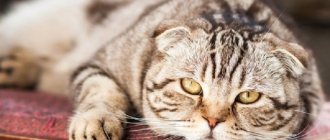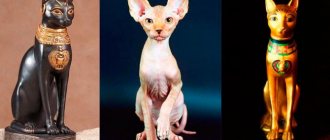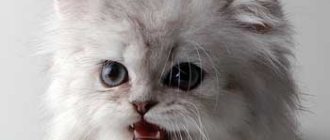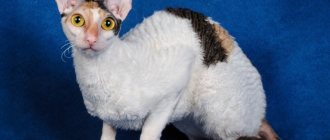Congenital osteochondrodysplasia of Scottish fold cats (OCD) is considered a common disease of bones and joints, the signs of which appear already in the first months of life of a cat of this breed. It will not be possible to completely defeat the disease, but it is possible to control the course of the pathology by using medications and vitamins prescribed by a veterinarian that help strengthen bone tissue.
What affects health?
Scots, despite their charming appearance, are quite gentle and delicate in health for an experienced breeder.
In the process of raising Scottish Fold cats, you can encounter the following common diseases. These diseases, as a rule, do not directly affect the life of a young Scot, but they begin to actively manifest themselves in adulthood. Because of this, the pet begins to have problems with gait, running, and begins to limp. In turn, a lack of active games and entertainment leads to the development of obesity and a decrease in muscle mass. All these diseases can shorten the life of Scottish Folds by 3 or even 4 years.
- Grooming. Long-haired Scots breeds have surprisingly long hair, which without proper regular care can literally prevent the animal from moving. In addition, the formed wool tangles often become a haven for ticks and lice, as well as a source of development of inflammatory skin diseases. Poor grooming can also lead to physical inactivity (atrophy and weakening of the muscular system) if your pet does not move around much.
- Scottish Folds also love to lick themselves, which leads to swallowing a lot of long hair. Because of this, real hairballs and compactions often form in their stomach, which are then very difficult to remove from the body due to blockage of the passages. This can lead to complications in the gastrointestinal tract: diarrhea, constipation and loss of appetite.
In addition to the listed diseases, Scottish Folds are also characterized by other diseases typical of other cat breeds: skin diseases (fungal diseases, abscesses, abscesses, ulcers, rashes, allergic reactions), infectious diseases (salmonellosis, rabies, anemia, candidiasis), eye pathologies (pupil dilation, tear ducts, lens clouding), heart disease (hypertrophic cardiomyopathy), and some cancers.
Myelopathy
Myelopathy is a collective concept. This includes almost all diseases that in one way or another lead to morphofunctional disorders in the spinal cord. Depending on the location of the lesion and the advanced state of the case, symptoms can vary from mild paresis or pain to complete paralysis. Paresis or paralysis can affect all four legs (tetraplegia), the hind legs (paraplegia), the front legs (hemiplegia), or just one leg (monoplegia). How do myelopathy of various etiologies manifest? Clinical signs include:
- Uncoordinated movements, ataxia.
- Decreased muscle mass, even if the animal eats normally.
- Decreased muscle tone.
- On the contrary, in other cases, constant muscle tension (hypertonicity) can be observed.
- Problems with bowel movements and urination (involuntary release of feces and urine).
Let's consider the main predisposing factors that most often contribute to the development of myelopathy. Firstly, this is unfavorable heredity. Today, almost all veterinarians believe that some breeds (Persians, Siamese cats, their crosses) have many defective genes, which are especially pronounced in certain families. It is strongly recommended to sterilize such animals and completely exclude them from reproduction.
Ischemic lesions of the spinal cord are very dangerous. As in the previous case, unfavorable heredity is of great importance. The second cause of circulatory problems is bacterial and viral infections, as well as the uncontrolled use of certain medications, which many breeders are guilty of. The most dangerous diseases are: feline viral leukemia (FeLV) and cryptococcosis caused by pathogens of the species Cryptococcus neoformans. The latter is also very dangerous because it affects not only the spinal cord, but also the brain. Two more groups of reasons can be distinguished:
- Cancer. Lymphoma, meningiomas, and histiocytic tumors are especially common in cats. When detected, the prognosis ranges from questionable to unfavorable.
- Traumatic myelopathies. As a rule, they develop against the background of biting and puncture wounds affecting the area of the spinal column, fractures and degenerative lesions of the intervertebral discs.
For an accurate diagnosis, it is advisable to conduct a computed tomography, MRI (magnetic resonance imaging), as well as (or at least) radiography of the spinal column. A sample of spinal cerebrospinal fluid (CSF) is necessarily taken (by puncture), since the analysis of this fluid with a high degree of reliability allows us to identify various types of inflammatory and infectious pathologies.
The course of treatment will depend on the underlying cause of the myelopathy. Thus, only surgery can help with fractures and tumors; in case of infectious pathologies, antibiotics and other antimicrobial drugs are prescribed. But no less important is the recovery period, which often determines how fully the cat’s motor functions will be restored, and whether there will be any pathologies in his behavior.
Since many cats with spinal cord lesions have serious problems with urination and defecation, it is the owner's responsibility to massage the bladder and rectal area, then remove feces and wash soiled areas. If the cat is unable to sit, it must be turned over at least once every six hours while being massaged. This is done to prevent the formation of bedsores.
What ailments are there?
Diseases significantly shorten the life of fold-eared cats, so they may not live long depending on the disease. The most common:
- Osteochondrodysplasia. Characterized by skeletal deformation. Highland Fold and Scottish Fold breeds are at high risk of getting the disease. Straight-eared people are less susceptible. Proper treatment and care stops the disease and the cat can live to an old age.
- Hemophilia types A and B. Characterized by a blood clotting disorder and prolonged bleeding at the site of even a small cut. How many years Scottish cats with this diagnosis live depends on other anomalies of the body, since internal bleeding leads to rapid death.
- Eye diseases. A fold-eared or straight-eared cat often suffers from eversion or inversion of the eyelids, which provokes conjunctivitis, keratitis or blepharitis. Eye diseases do not affect a cat’s life expectancy if you consult a veterinarian in a timely manner and stop the inflammation.
- Ear ailments. The most common are otitis media, deafness and tumors due to the abnormal structure of the hearing organ. With proper care, your cat will live a long time. However, if the neoplasm is malignant, metastases may form and life expectancy will be significantly reduced.
- Deterioration of immunity. Pedigree cats have reduced body defenses, so they are susceptible to viral and bacterial diseases. Serious diseases (panleukopenia, rhinotracheitis) can “take away” your pet much earlier than expected.
- Metabolic disease. Spayed and neutered pets who suffer from hormonal imbalance suffer the most. This leads to obesity or diabetes.
History taking
Anamnesis is information about the patient and his disease obtained as a result of a survey.
It is well known that any medical appointment begins with a questioning of the patient. It is very important for the patient to correctly describe the nature of the pain, what exactly the ailment is, how long ago the first symptoms appeared and what they are associated with, and whether relatives have similar problems. When you visit a veterinarian, your pet cannot talk about the problems that are bothering him. Therefore, it is very important that the owner correctly assesses what exactly is happening to his dog or cat and clearly describes the symptoms.
For example, if your pet has problems with the gastrointestinal tract, you may notice vomiting and a change in stool consistency. Here it is very important to tell the doctor: exactly when the vomiting begins, whether it is related to food intake, and what the vomit looks like. If there is loose stool, what color is it, is there any blood in it, how often does the dog have bowel movements.
If cardiac problems are identified, it is necessary to clearly describe when shortness of breath appears, whether it is associated with physical activity, whether there is a cough, whether fainting attacks have been observed, what color the dog or cat’s mucous membranes are during attacks or at rest.
If you have problems with urination, how often does the urge occur, what color is the urine, how severe is the pain, has your thirst increased.
Depending on the disease that has manifested itself, the doctor will ask a certain set of questions, and you should understand well that the better you describe the situation, the easier it will be to make a preliminary diagnosis and begin treatment.
How is the diagnosis made?
An examination is sufficient for a preliminary diagnosis. If you have a fold-eared kitten (or an adult cat) and you observe the following symptoms, you may suspect OCD:
– began to limp for no particular reason.
– the gait has changed. Protects one or more limbs, hunches over.
– there is a delay in growth, a violation of proportions (short legs, tail...).
– you observe deformation of the joints, most often the hind limbs are affected.
– the tail loses mobility, becomes like a “stick”, and when trying to bend the animal experiences pain.
To clarify, an x-ray is taken. The image evaluates the density of bone tissue, whether there are anatomical changes in the joints, the presence of bone exostosis (growth) and other changes.
The doctor may also recommend additional tests: general blood test, blood biochemistry, ultrasound…. In order to exclude other diseases or identify disorders that often develop in parallel with osteochondrodysplasia.
For example, kidney disease, mineral metabolism disorders, etc.
How it manifests itself
It is very difficult to notice articular pathologies in cats, because... This type of animal very well masks the pain that occurs while walking by limiting its movements. Arthritis in cats does not have the classic symptoms like in dogs, for example, so the pathology is not always detected in a timely manner.
What may attract attention:
- limited mobility: the cat lies down a lot, often stays in one place for a long time in search of a comfortable position, stops jumping on high surfaces, refuses to go up and down stairs;
- staying in one position for a long time during sleep, when stretching - meowing;
- the duration of rest and sleep is many times longer than periods of wakefulness;
- Difficulty getting through cat holes in doors;
- refusal to play;
- deterioration in the condition of the coat due to the inability to bend in the necessary positions for licking;
- the formation of bald patches and/or bald spots in the joint area due to constant licking;
- aggression towards a person when trying to pick up a cat and towards other pets who are trying to contact the cat;
- visible swelling of diseased joints, increased local temperature, pain when trying to palpate them;
- the appearance of puddles in the wrong place due to difficulties getting into the tray;
- the appearance of excess weight against the background of decreased physical activity;
- against the background of general malaise, appetite may decrease and the temperature of the whole body may increase.
Causes of the disease
OCD, the abbreviated name for feline osteochondrodysplasia, is a genetic disease. The gene that is responsible for the formation of the auricle can play a cruel joke on the animal’s body as a whole.
What we see is a beautiful crease in the ear, this is only part of the picture. Changes in cartilage tissue, disruption of its formation, can occur throughout the entire skeleton, and affect not only the ear.
And cartilage tissue plays an important role, primarily mobility. Any joint, intervertebral joint... will not be able to function normally without healthy cartilage.
When the formation of cartilage tissue is disrupted, then we get complications, and they will manifest themselves to varying degrees.
The likelihood of developing osteochondrodysplasia depends on the parents. If both parents are lop-eared (folds), then the likelihood of developing OCD in the offspring is very high. If one parent is fold and the other is straight (with straight ears), then the disease rarely appears, but it can also happen.
Violations also occur if one parent is a Scottish Fold and the other is of any other breed. Yes, such a combination can also happen when breeding is not carried out by professional breeders. The demand for fold-eared kittens is high, so many people breed them.
Diagnosis of the disease
To prescribe adequate treatment, your veterinarian will need to find out the history of arthritis in your cat. This will help to understand the clinical picture and correctly identify the disease and its subtype. Before visiting the clinic, prepare answers to frequently asked questions:
1. What type of movement restrictions did the animal begin with? Did they start suddenly or did it take some time? How long does it last? Are there any signs of deterioration?
2. Which limbs are suspicious? Are there other unrelated symptoms? What's your appetite?
3. Does the animal participate in shows or breeding?
4. When were the last injuries? What diseases did you have? Have you come into contact with carriers or patients?
5. What types of vaccines were used and when? Is he taking medications? What kind of nutrition does he receive?
6. Did your parents have pathologies of muscles, nerves, bones?
If the cat is in obvious pain, the doctor will use an anesthetic to make the examination more comfortable.
Diagnosis begins with a radiograph or x-ray, which will help assess the damage and determine a treatment regimen. The processes in the damaged organ can be very small, so x-rays are taken from all sides at different angles. Usually other procedures, such as ultrasound, MRI or CT, are done to get a more complete picture.
Blood is taken for a complete analysis. Different cell types are being studied. The result will tell your veterinarian what could be causing the lameness. Serological tests are used - these are tests that are carried out for various immune pathologies or bacteria. For example, they may detect Lyme disease or rheumatoid inflammation.
If the doctor sees swelling, he places a thin needle into it and collects synovial fluid, which is then carefully examined. The test accurately determines the presence of infection, impaired immunity, or injury. For a bacterial infection, the type of strain is determined, which is important for prescribing a course of antibiotics.
But sometimes even these tests are not enough to make a definitive diagnosis. In this case, a biopsy is performed: a small piece of tissue lining the organ is removed and then examined. This type of analysis is especially useful for detecting cancer.
The biopsy is performed using arthroscopy, which means inserting an endoscope through a tiny incision. Such gentle examination is increasingly used in veterinary medicine. Using an arthroscope, the doctor can examine the inside and take material for analysis.
In rare cases, arthrotomy (exposure of the area) is used in small individuals whose limbs are too small for such an examination. During arthrotomy, the organ should be examined, a biopsy taken, and, if necessary, the connective cartilage should be restored.
How to extend the life of a pet
Let's find out what procedures will help your pet live longer:
Timely vaccination
Please note: even if your pet lives exclusively at home and never goes outside, harmful microorganisms can enter the house via outdoor clothing and other items. Balanced diet. If you prefer to give your cat commercial food, it should be premium or super premium.
Natural nutrition should include a large amount of protein: lean meat, fermented milk products, deboned sea fish once or twice a week. Vegetables are good for you. They can be given raw or cooked, depending on the cat’s preferences. Your pet should always have access to clean water. After consulting with a veterinarian, you can purchase mineral supplements for your pet to strengthen bones and cartilage tissue. Hygiene procedures are important. About 2 times a month you need to clean the animal’s ears using cotton pads and a special gel (sold in pet stores). A short-haired pet should be brushed once a week using a brush with short, stiff, dense teeth. The long-haired variety of Scottish cats is combed daily using a comb with sparse long teeth. It is not advisable to use slicker coats for Scots. Sterilization increases the life of a pet by 2–3 years (regardless of gender).
Do not forget that how long your pet will live largely depends on you.
At what month did your Scottish kitten start sitting on his butt?
Hello! We recently got a Scottish Fold kitten, he is two months old. I know that the breed’s peculiarity is the ability to sit on its butt with its hind legs forward and its front legs on its tummy. There are a lot of photos of this miracle in a funny pose on the internet. I haven’t noticed this pose with my cat yet. Tell us how it was for you, maybe they develop this position as adults? Thank you!
I've never sat like that. But she lies on her back, bends her front and back legs and purrs so that they pay attention to her. She stretches out differently, when she was little she stood on her hind legs when she saw something interesting. It's not worth it now. The cat is 11 months old.
Mine sits like this all the time, takes up an entire chair, not a Scottish Fold, just an ordinary Siberian. But he started sitting like this not as a kitten, but already at age
Mine sits like this all the time, takes up an entire chair, not a Scottish Fold, just an ordinary Siberian. But he started sitting like this not as a kitten, but already at age
Around 4-5 months. Before that, she tried but tumbled)) it didn’t work. The woman has grown up, gotten stronger and everything is ok. But there are 2 poses - one like a meerkat - she rarely sits like this if she asks for something or sees something curious, and directly on her butt with her paws spread - this is when she sleeps, washes, and it’s just convenient for her to sit like that among the pillows on the sofa)))) )) He sleeps exclusively on his back with his legs stretched out, rarely on his side))) So funny))))
Hello! We recently got a Scottish Fold kitten, he is two months old. I know that the breed’s peculiarity is the ability to sit on its butt with its hind legs forward and its front legs on its tummy. There are a lot of photos of this miracle in a funny pose on the internet. I haven’t noticed this pose with my cat yet. Tell us how it was for you, maybe they develop this position as adults? Thank you!
It is not good. Cats shouldn't sit like that. Possible problem with the musculoskeletal system
Source
Symptoms and development of the disease
The disease usually develops in adult Scottish cats, but the first signs, missed by cat owners, may appear in kittens during the period of “dropping” of the ears (Scottish Folds are born straight-eared).
During the period of intensive development of the disease, its symptoms become obvious. Here are the most common ones:
- the animal's tail has a disproportionately thin base;
- the gait changes, unnatural growths called exostoses appear on the paws - they prevent the cat from moving normally;
- loss of flexibility of the tail, its thickening as a result of the proliferation of cartilage tissue, also observed in the area of the limbs;
- deformation of the jaw apparatus: changes in bite, curvature of the jaw, protruding teeth;
- thickening in the joint area, imbalance in the proportions of the body and head;
- development of a painful symptom when walking, which the animal signals by anxious meowing and refusal to play outdoor games;
- slower skeletal growth;
- Difficulty jumping onto various surfaces.
If you find at least one of the alarming signs in your pet, you should immediately contact your veterinarian. Only a doctor can confirm or deny the presence of a mutation.
Symptoms and signs of osteochondrodysplasia in Scottish cats
In animals with osteochondrdysplasia, activity sharply decreases; the pet refuses to jump and run. He is in pain. In young cats, signs of the disease may not be noticeable to the owner. Due to its light weight, the animal distributes the load on its healthy limbs. The disease progresses with age.
Sick cats experience:
- Difficulty moving
- Change in gait
- Curvature of limbs
- Big head
- Short nose, protruding jaw
- Crooked teeth
- Lameness
- Short hind legs
- Enlarged joints
- Reluctance to jump high
The lower parts of the animals' limbs are short and underdeveloped, which is why cats have a squat appearance. The tail is short, motionless, thin at the base. Signs of the disease in a cat can appear both at a young and old age. If your cat begins to move little, practically does not jump, or has a stilted gait, contact a veterinarian.
To make a final diagnosis of osteochondrodysplasia, the doctor will ask you to provide the cat's pedigree. A general and biochemical blood test and urine test will be taken. He will take an x-ray of the limbs and spine. An X-ray examination reveals characteristic changes in the area of the tarsal joint, wrist joint and spine.
“Vulnerable” places of Scottish folds
Scottish Fold is classified as an undemanding strong breed. But every artificial species has “vulnerable” places.
What problems do owners of fold-eared cats encounter?
- Diseases of the musculoskeletal system. In adulthood, problems with the development of bone and cartilage tissue begin.
- Cats easily gain excess weight as a result of a sedentary lifestyle and an unbalanced diet. This gives impetus to liver and heart dysfunction, and the risk of serious problems increases.
- The ear is the weakest point of the Scottish Folds. Responsible owners of fold-eared cats regularly inspect their pets' ears and clean them of dirt and wax. Otherwise, an inflammatory process appears and enters the chronic stage.
- Long-haired cats suffer from the appearance of dense mats due to insufficient coat care. This reduces mobility and negatively affects muscle tissue throughout the body.
Be sure to read: Lilac British cat: features of the breed’s appearance, characteristics, behavior, care
There are diseases that are most often inherited by Folds.
What diseases do cat owners face:
- Osteochondrodysplasia. Health problems can be identified by lameness and hardening of the tail.
- Osteoarthritis is joint stiffness.
- Hypertrophic cardiomyopathy is a problem with the functioning of the heart.
- Polycystic kidney disease.
Health
Most cats of this breed have excellent health, good immunity and endurance.
But there are many disorders and diseases characteristic of British fold cats. The cause of the majority of cases of genetic diseases in these animals is an altered gene that is responsible for the formation of ears.
1 Osteochondrodystrophy. The most common disease affecting fold-eared cats is osteochondrodystrophy. This is a genetic disorder that leads to skeletal deformities and causes osteoarthritis. The main deformations are a thickened, motionless tail, deformed, crooked paws.
Shortening of the limbs and tail is also characteristic. In addition to appearance, the presence of the disease is indicated by the behavior and movements of the cat. A sick animal does not jump, moves little, walks without bending its paws.
Osteochondrodystrophy is caused by impaired development of cartilage. This disease occurs when two fold-eared cats are crossed, and also in large dogs.
Experts recommend stopping the breeding of fold cats, as well as limiting the breeding of shorthaired Scottish cats due to the manifestations of this disease. There is no cure for this condition. Often leads to complete paralysis and suffering of animals.
2 Another serious disease characteristic of Scottish fold cats is hemophilia type B. It is expressed in the fact that during injuries and operations, the blood in wounds or incisions does not clot.
In other words, it is bleeding. The crust that forms on the wound consists mostly of fibrin. If an animal has hemophilia, there is not enough fibrin in the blood, so after the platelet plug disappears, bleeding resumes.
3 Other diseases that fold-eared cats are prone to are divided into:
- ophthalmic;
- ear;
- skin;
- diseases of internal organs;
- dental diseases.
What you need to increase your cat's lifespan
In order for a pet to live 15-20 years, it is important to carefully approach its purchase and follow all the recommendations of specialists when caring for it. There are several tips that are usually given to those who decide to get a Scottish kitten:
- Contact a trusted breeder and choose a healthy kitten with special care.
- Let it be a female, since female Scottish cats live a little longer than males.
- Follow all veterinarian recommendations and get vaccinations on time.
- Ensure the kitten's safety by removing wires and anything that could injure him.
- Sterilize the animal in a timely manner.
- Don't let him go outside.
- Feed correctly, preferably natural food.
- Provide your pet with communication, affection, and play with him more often.
Forecasts
The lifespan of Scottish cats affected by osteochondrodysplasia is difficult to predict in advance. It largely depends on how willing the owners are to care for a disabled kitten.
For long-term prognosis, it is necessary to exclude other genetic diseases of Scottish cats, which can occur with irresponsible breeding as often as osteochondrodysplasia. This is polycystic kidney disease and which can be detected using ultrasound.
With mild osteochondrodysplasia, cats can live for years, although they require constant supportive treatment and special housing conditions. For example, it may be painful for them to go to the toilet, which leads to urination in the wrong places and chronic urination.
If the sick kitten is homozygous for the lop-eared gene (both parents are Scottish Folds), the prognosis for life is extremely unfavorable. Bone deformation causes severe pain, which becomes increasingly difficult to relieve with age. The animal cannot move, and at some point the owners resort to euthanasia as a means of ending the suffering of their beloved pet.
Appearance. What do Scottish Folds look like?
A striking feature of this breed is its erect ears. Among canine representatives there are many breeds whose ears do not stand up - Labradors, pugs, collies, spaniels, Airedale terriers, bulldogs, shelties, retrievers and others. The cat population cannot boast of such diversity; only the ears of the Scots, and with rare exceptions of the British, hang, and do not stand upright. This determines the popularity and unusualness of the breed.
Interesting fact: the second name of the breed, often found in veterinary reference books and books on animal care, is Scottish Fold.
The size of the cat is average: Scottish Folds have a medium-sized body with a rounded shape, with powerful and well-developed muscles, the shoulders and chest are well developed. The paws are thick, of medium length, massive and large, with delicate rounded pads. The color of the wide, bright eyes with mysterious sparkles varies depending on the color of the coat.
The jaw is well developed; a large oval or round head gently transitions into a wide neck; the ears are small, rounded towards the bottom; the nose is large and wide.
The coat is medium length, soft to the touch, like plush; tail of medium length, rounded at the end. The color can be any: breeders have bred seventy-five species of these wonderful animals.
Symptoms
Signs of the disease: shortened, deformed limbs, very short, thick tail.
The rate of progression, the onset of clinical signs and their severity can vary greatly among animals from different litters. Scottish kittens' ears begin to curl at about 1 month of age, and lameness and difficulty walking associated with osteochondrodysplasia usually appear after the kittens are weaned, at 7 weeks of age or older.
Symptoms of osteochondrodysplasia:
- shortened and deformed legs;
- unnatural, stilted gait;
- lameness in one or more limbs;
- general signs of pain (the kitten meows when stroked, does not play, is inactive, cannot jump or run).
An indirect sign of the disease will be unnaturally short, thick, straight and stiff with a thin base. Due to underdeveloped limbs, the kitten has a “crouched”, squat appearance.
The older the kitten gets, the more difficult it is for him to move. This is due to the fact that the weight of the animal increases, and therefore the load on the damaged joints.
How long do cats usually live?
Representatives of small cats in the wild live relatively short lives - 5-6 years. The lifespan of stray cats is approximately the same. Reasons for this:
- poor diet;
- irregular meals;
- invasive diseases;
- infections;
- lack of protection from predators;
- stress associated with the struggle for survival;
- harsh climatic and weather conditions.
The shortest lifespan—4 years—is for cats that, by chance, end up on the street. After a comfortable stay at home, they do not adapt well to the new environment. The fate of neutered cats is even sadder: being unable to compete for a place in the hierarchy, they immediately become outcasts from the pack and do not live more than three years. A little more time—approximately 3.5 years—is given to cats whose bodies are exhausted by constant pregnancies, childbirth, and nursing offspring.
Different fate and life expectancy for cats with loving owners
Care and attention, human patronage, and the opportunity to receive veterinary care allow them to live 15 years or more
The absolute champion in survival is the cat Lucy. At the time the record was entered into the Guinness Book (2011), according to the owners, she was 39 years old.
Return to content
Ear diseases
As already mentioned, an altered gene responsible for the structure of a cat’s ear often leads not only to a change in the shape of the auricle. Thus, lop ears are often accompanied by deafness or hearing impairment.
Because the shape of the ear is not what it should naturally be, this leads to the accumulation of dirt and infections of the outer or inner ear. For example, diseases of the outer ear are more common. These are a variety of otitis media and tumors of the ear canals.
Symptoms of ear diseases in cats include ear discharge, odors, ear skin irritation, and head shaking.
Source sustaw.top
Osteochondrodysplasia is an incurable disease. Scottish fold cats are at risk. Learn about the causes and methods of preventing the disease.
How to increase the lifespan of a Scotsman
Thanks to many advances in veterinary medicine and the development of the pet business, the lives of pets have become much longer and more comfortable. To ensure that 15 years is not the limit for the life expectancy of a Scottish Fold, its owner must be responsible, starting with the choice of a kitten and throughout the pet’s life.
You should only purchase a fold-eared baby from a conscientious, reputable breeder or at a cat show.
This solution minimizes the risk of purchasing a sick animal. Particular attention should be paid to issues of maintenance and care. Even before the furry newcomer appears in the house, you need to decide on the type of food he will eat, whether it will be factory-made food or natural products. When choosing ready-made food, preference is usually given to the “super-premium” and “holistic” classes: these lines take into account the age, breed and individual characteristics of cats. A natural diet should be balanced, varied, meeting the needs of carnivores in general and Scottish Folds in particular: contain not only all nutrients, but also taurine, which Scottish cats, like all other cats, do not produce on their own.
- Routine and preventive examinations by a veterinarian are required, as well as timely vaccinations against rabies, panleukopenia, chlamydia, calcevirosis, and rhinotracheitis.
- Given the propensity of the Scottish population for cardiomyopathy and the difficulty in diagnosing this disease, ultrasound of the heart and chest should be included in the examination.
- Monitoring the condition of the gums and teeth must be constant: dental problems lead to diseases of the digestive system.
- If breeding a breed is not the purpose of purchasing an animal, it is advisable to sterilize it in due time.
- Regardless of whether the Scottish Fold is outdoors or in contact with other animals, periodic anti-parasitic measures are required.
- To maintain muscle tone and good shape, your pet needs to be provided with physical activity through games and training.
Such careful care and sincere love will allow the Scottish Fold to live to the respectable age of twenty.
Return to content
Health and life expectancy
Unfortunately, Scots are prone to several breed diseases at once. Some of them:
- osteochondrodysplasia of Scottish fold cats;
- brachycephalic syndrome;
- diseases of the cardiovascular system;
- partial or complete obstruction of the tear ducts.
In order to choose a kitten free from genetic pathologies, you need to thoroughly study the breed, take a closer look at the parents of the little Scotsman and have the animal examined by a veterinarian in a timely manner. Heart pathologies can only manifest themselves by the age of five, so before this age, a Scottish cat should visit a veterinary cardiologist at least twice.
Important! Scottish cats live on average 10-15 years, but there are long-livers who felt great even at 18 years old. Although this is already a very old age for cats. Timely castration or sterilization prolongs the animal's life.
When to castrate a Scottish Fold cat
Castration of cats is a simple operation that is traditionally performed in every veterinary clinic and lasts no more than 20 minutes. First, the animal is given anesthesia (intravenously or intramuscularly), then small incisions are made in the skin of the scrotum, after which the spermatic cords are ligated and the testes are removed directly. After surgery, cats do not need stitches. The stump is treated with antiseptics, and a standard set of medications is administered (antibiotics, hemostatic agents).
In general, castration of cats always follows the same scenario, regardless of breed. The only question that needs to be resolved before the operation concerns the age of the animal of a particular breed. So, at what age are Scottish Fold cats neutered?
The optimal age for surgery to remove the testes in fold-eared cats is 10–12 months. This is the time when the cat reaches puberty. Some veterinary clinics offer castration of fold-eared cats at the age of 8 or even 6 months. Professional breeders categorically do not recommend doing this, since a disproportion of the head to the rest of the body may occur if the cat has not yet developed to its condition. As a result, the head will be too small compared to the weighty butt.
However, you shouldn’t delay castration too long, because if the cat has already become acquainted with the cat and periodically marks its territory, then after the operation he can continue to do this. But even in this case, the risk is no more than 10%.
Thus, the question of when to castrate a Scottish Fold cat depends on the speed of onset of puberty in him, which can be determined by certain signs:
- the smell of urine becomes stronger;
- the animal becomes restless and aggressive;
- the cat refuses to eat;
- the animal meows loudly and rushes around the apartment.
The above changes in the behavior of your pet are a reason to immediately contact a veterinary clinic.
Diagnostic measures
When a pet owner suspects that he or she has developed spondylosis, it is important to contact a veterinarian as soon as possible. The veterinarian will conduct a survey during which he will find out how long ago the cat’s spinal problems began and what symptoms were noticed. Then the doctor begins to examine and palpate the spinal column. Next, the animal is prescribed radiography, with the help of which it is possible to see changes and distinguish discopathy from traumatic spinal injuries. An x-ray image shows the following deviations:
- destruction or narrowing of intervertebral discs;
- degree of spinal cord damage.
If required, radiography is performed with the introduction of a contrast agent.
You can find out the location of a spinal disc lesion in a cat by performing an ultrasound examination.
Sometimes a cat is prescribed a magnetic resonance or computed tomography scan, but not all veterinary clinics are equipped with such expensive equipment. To confirm or refute the presence of an infectious process, a puncture of the cerebrospinal fluid is performed, which allows one to determine its composition. Bacterial culture is also required. To accurately detect the area of damage to the spinal column, ultrasound is used.
What to feed a cat with osteochondrodysplasia
The basis of nutrition for sick cats is proper balanced feeding using supplements that prevent fractures and joint destruction. It is desirable that the food be natural, but factory-made feed can also be used. If we are talking about ready-made food, then these are complexes containing vitamins, macro- and microelements. Supplements and the diet itself should be rich in calcium, vitamins B and E, phosphorus, iodine and iron. Among professional food brands there are even special lines for cats with joints. Such feeds and supplements additionally contain chondroitin and glucosamine, which in combination mutually enhance each other.
If the cat eats a natural diet, then it should include raw cartilage, sinew and meat, rich in natural glucosamine and chondroitin. But the opinion about the need to cook jellied meats for such cats is wrong. All the substances that were originally in the cartilage and meat are no longer present in the digestion, and many pass into a form that is difficult to digest. Everything you need is already in the raw product.
It is also worth considering that cats with joint diseases are susceptible to obesity, because it is unpleasant or even painful for them to move. The owner must monitor the calorie content of the diet by regularly weighing the animal and identifying deviations in time. If the cat is already obese, it is necessary to select food for weight loss, because... excess fat threatens heart disease and greater stress on the musculoskeletal system. If your cat is of normal weight, still try not to overfeed her, because... a cat with reduced physical activity needs fewer calories.
Prevention of dysplasia in cats
When breeding purebred animals, it is necessary to monitor cases of dysplasia in close relatives. It is recommended to remove kittens with poor heredity from breeding by castrating or sterilizing them.
The cat must have a soft bed. For large, fast-growing breeds, it is important to feed them with high-quality feed containing all the substances necessary for joints. Pets should not be allowed to become overweight. Breeds that are at risk (Maine Coons, Scottish Folds, British Folds) should be regularly examined by an orthopedic veterinarian.
Large cats need to be provided with a soft sleeping place.
Purchasing kittens from reliable breeders will reduce the risk of your pet being diagnosed with dysplasia. If the cat does get sick, then timely consultation with a doctor and proper treatment will reduce the likelihood of complications associated with dysplasia.
How long do sick cats live?
It is unlikely that anyone will give you a specific prognosis for the life expectancy of cats with osteochondrodysplasia. Unless such responsibility will be assumed by the treating veterinarian who has fully examined the animal. And even then the forecasts are often wrong. Also, veterinarians often mistakenly suggest euthanizing a seriously ill animal or cutting off a limb, although, in fact, with the correct selection of medications and proper care, as well as the patience and love of the owner, the cat’s condition can be seriously improved. Therefore, do not be upset immediately as soon as you hear from the doctor that the cat has no future. Be sure to consult with 1-2 more veterinarians. Only then make a decision!
The first signs of osteochondrodysplasia in Scottish fold cats can appear as early as a couple of months, so when choosing a kitten it is so important to pay attention to the behavior of the cat, the curvature of the paws, the presence of kinks in the tail, its mobility and length. It all starts with minor changes that may not be noticed if you don’t set such a goal. In most cats, the disease becomes noticeable later, when they have already found permanent homes.
In most cats, the disease becomes noticeable later, when they have already found permanent homes.
The rate at which the disease progresses and its severity varies among individuals. The time of visible manifestation of the disease is the same. However, veterinarians recommend that all owners of fold-eared cats closely monitor the condition of the pet and, at the first signs, run to the veterinary clinic, because further quality of life will directly depend on how early treatment is started.
To increase the life expectancy of a sick cat, it is necessary, in addition to drug therapy, to balance the diet and prevent the appearance of excess weight, because it creates additional stress on the musculoskeletal system.
Pets with especially severe manifestations of the disease once again try not to move. Sometimes it is even difficult for such cats to reach the litter box, and therefore they may relieve themselves in the wrong place or on their own. If this has become a system, you can purchase special cat diapers. Then the cat will urinate and poop in them, thereby saving you from unnecessary problems.
If your cat is diagnosed with such a disease, we would like to advise you not to despair. For inspiration, watch a video about a rescued cat with osteochondrodysplasia, who, due to illness, was kicked out of the house by her owners in 40-degree frost, but a few days later she was rescued by volunteers, came out, and now she lives happily in a new family.
However, in some cases it is still recommended to euthanize the cat. These are cases of severe progressive disease with pain. If the animal is suffering, cannot lead a normal life, is constantly on pills that do not help much, veterinarians advise stopping the cat’s suffering. And in this case they are most likely right. However, the final decision is up to the owner.
Scottish cats: description of the breed, character
Breed standards and behavior can vary dramatically. But to think that appearance somehow influences character is fundamentally wrong. It cannot be said that someone is more affectionate or, on the contrary, harmful. Each cat is an individual and does not lend itself to general characteristics.
Scottish fold cat: character, breed description
Owners of Scottish dogs are distinguished by a strong attachment to a person, and they always want to be in at least the same room with their beloved owner. The character of the Scots is soft, lazy, but at the same time intelligent and aristocratic.
Important! The Scots are also very talkative and this is their distinctive behavior. They not only meow and purr, but also seem to talk, actively using a wide variety of sounds.
The Scottish cat has a more demanding and independent character than the cat. The females are more like the British, their close relatives. The character of the Scottish cat is not so expressive, and they are also more affectionate with people. Therefore, boys are more often chosen for home care.
Treatment
The success of treatment for feline OCD depends on the degree of damage to the skeletal system. The earlier the disease is detected, the greater the chance of a good prognosis. Already developed skeletal changes persist until the end of life, but adequate therapy can slow down or even stop their further development.
In any case, treatment measures are primarily aimed at eliminating the main symptoms of osteochondrodysplasia: relieving pain, inflammation and joint stiffness. If your pet does not suffer from kidney disease, he may be prescribed non-steroidal anti-inflammatory drugs: Meloxivet, Ketoline, Ainil.
To stimulate the proper development of cartilage tissue, Pentosan can be prescribed, which has a chondroprotective and anti-inflammatory effect, as well as glycosaminoglycans involved in the construction of the cartilage matrix:
- Chondroitin-4-sulfate;
- Chondroitin-6-sulfate;
- Furinaid;
- Interpan.
These drugs slow down the processes of degeneration of bone and cartilage tissue and maintain the amount of synovial fluid in the joint capsule at the proper level.
Manual therapy or massage can alleviate the animal’s condition, but these physical procedures must be performed by a professional specialist. In severe cases of osteochondrodysplasia, your pet may need surgery to remove bone growths called exostoses that have formed on the joints. After such an operation, the cat’s lameness usually decreases and pain is partially or completely relieved. In some countries, radiation therapy is used to treat OCD.
Important! To improve the quality of life of a cat suffering from osteochondrodysplasia and increase its life expectancy, in addition to drug therapy, it is necessary to organize a balanced diet and prevent the development of obesity, since excess weight is an extra load on the skeletal system weakened by the disease. If your cat has signs of osteochondrodysplasia, his diet should be special
The diet must include specialized supplements that help strengthen bone and cartilage tissue: calcium, phosphorus, iron, iodine, B vitamins. This will prevent the possibility of fractures and slow down degenerative processes
If your cat has signs of osteochondrodysplasia, his diet should be special. The diet must include specialized supplements that help strengthen bone and cartilage tissue: calcium, phosphorus, iron, iodine, B vitamins. This will prevent the possibility of fractures and slow down degenerative processes.
Veterinarians consider the best food option for cats with OCD to be natural, home-cooked food. If ready-made feeds are used, then you should choose specialized complexes intended for animals with diseases of the musculoskeletal system. Such complexes contain all the necessary vitamins, macro- and microelements.
Osteochondrodysplasia in a Scottish fold cat is not a death sentence. With timely detected pathology, proper treatment and competent, caring care, your pet can feel good and live a long life.
- Feliferon for cats
- Chelavit for cats
- What food to feed a British cat
Features of the care and maintenance of “Scots”
Scots are an unpretentious breed, which, however, requires special care. Caring for Scottish cats is not difficult, but it has its own specifics that you need to know about.
Coat care
Akita Inu: description of dog breed, character
Plush fur does not require special care, but a cat that lives in an apartment and is warm all year round may be constantly shedding. There is no pathology in this, it’s just that the cat’s body does not grasp the system of changing seasons.
Due to constant shedding, a cat's fur requires regular brushing. If this is not done, tangles may form that cannot be removed with a comb.
For express shedding, you can contact a groomer. The cat groomer will comb your cat and tell you how to care for its fur. For combing at home, it is best to use a furminator. It makes it much easier to remove excess hair.
For reference! Dry air can also lead to heavy, constant shedding. In this case, buying a humidifier will change the situation.
Bathing
Cats are very clean animals and do not require special water procedures. Bathing is very stressful for a cat.
You only need to wash a Scotsman if he has gotten very dirty in something.
Important! After washing, the cat must be dried thoroughly. If this is not done, the kitty may catch a cold.
Dental care
The Scots do not require any special dental care. But some cats can develop plaque that develops into tartar.
To prevent these conditions, you can give hard treats that remove plaque from the teeth. Also, cats with a predisposition to the appearance of plaque and stone are recommended to visit the veterinarian once every six months. In advanced cases, the stone is cleared using an ultrasound scaler under general anesthesia.
Eye care
The Scottish cat has a short, flat face, so drooping eyes are normal for Scottish cats. This is called "brachycephalic syndrome."
Normally, tears, moistening the eye, should flow into the nasolacrimal duct. In Scots, due to their short muzzle, the nasolacrimal duct may be deformed or completely closed. Therefore, tear fluid overflows over the edge of the eyelid, and smudges appear under the eyes.
Brachycephalic syndrome and its consequences
If your pet has this problem, the best solution is to use a special eye wash lotion. Instead of lotion, you can use boiled water or aqueous chlorhexidine.
Important! You cannot use tea leaves to wash your eyes, as the tea leaves contain microorganisms that can form pathogenic microflora in a cat’s eye.
Nail care
Some Scottish cats have uncontrollable nail growth and this needs to be monitored. Normally, when using a scratching post, the cat removes the top layer of its claws, thereby grinding them down. But some Scots neglect the scratching post (perhaps due to joint pain).
If an ordinary cat can have its claws trimmed only when necessary, then the Scottish paws need to be given attention monthly. If this is not done, the claw will bend and dig into the paw pad with its sharp part, causing pain to the animal.
To properly trim a Scotsman's claws, you need to press the cat's finger from above - then the claw will “come out” of the paw, and cut off its tip to the pink border.
Important! If you accidentally touch the pink part of the claw, you can damage the vessel. To stop bleeding, hydrogen peroxide or potassium permanganate in powder form is used.
Nutrition
Scots are usually not picky eaters and choosing food is not difficult. A proper diet helps the cat’s body maintain immunity, prevents urolithiasis and eating disorders.
With the purchase of a Scottish cat, the owner is faced with the question of what to feed the animal. The choice has to be made between a natural diet and ready-made food. When deciding to feed an animal natural food, it is necessary to create a diet. To do this, you need to visit a veterinary nutritionist.
From food the cat should receive:
- proteins;
- carbohydrates;
- fats;
- minerals;
- essential amino acids;
- fiber;
- vitamins;
- macro- and microelements.
Important! Only a specialist can choose the right diet! Feeding your cat "from the table" can lead to digestive problems.
Feeding commercial food saves the owner from preparing food specifically for the cat, and it is also more economically profitable. All the necessary elements are already in the food, in the best combination. The owners just have to calculate the portion. A hint about the amount of food per day is always on the back of the pack.
Food is divided into classes: economy, premium and super-premium, and also comes in the form of dry food, spiders, canned food and mousses. More or less good food starts from the premium class.
Economy food contains too few nutrients, and the cat must eat too much to be satisfied. Sooner or later this will lead to obesity.
It is impossible to say unequivocally that some food is good and some is bad. There is food that is suitable for a particular cat, and if there is one that will only cause the animal to become upset.
What is OHD
Translated from Greek, “osteo” means bone, and “dysplasia” means a developmental disorder. OCD is a genetic malformation of cartilage and bone tissue, leading to a slowdown in their growth. The result of this pathology is underdevelopment of the osteochondral system, including the ear cartilage (which is why cats of this breed have “falling” ears). Systemic skeletal lesions are most often expressed by deformation of the limbs. This disease often does not pose a direct threat to the animal’s life, but can significantly reduce its quality and duration.
Important! The purebred Scottish Fold and Highland Fold breeds are at risk for this disease. Both of them have a “defective” gene in their pedigree
If one of the cat’s parents was a Scottish Straight (Scottish Straight or Highland Straight), he will inherit one mutated gene, and the animal’s chances of developing osteochondrodysplasia will be halved.
Characteristics of the disease
Osteochondrodysplasia (OCD, osteochondrodystrophy) is a disease characteristic of representatives of the Scottish Fold breed. Its cause lies in the mutant gene for lop ears.
The drooping ears of representatives of this breed are caused by insufficient formation of cartilage and disruption of its formation. The gene encoding this trait is responsible not only for ear deformation, but also for disruption of the development of cartilage tissue throughout the body.
The lop ear gene is dominant. When crossing a Scottish Fold with a Straight, pathologies do not arise in the offspring, since such kittens have a dominant gene encoding floppy ears and a recessive gene responsible for the normal development of cartilage. As a result, the cartilage in the body of such cats is slightly deformed, which does not cause discomfort to the animal.
Crossing 2 lop-eared cats leads to the transmission of 2 dominant lop-eared genes to the offspring. The gene that determines the normal formation of cartilage is absent in such kittens. As a result, cartilage tissue develops poorly throughout the cat’s body, and in some parts of the body (for example, in the tail) it is completely absent.
In severe cases, not only cartilage tissue, but also bone tissue is subject to deformation, which leads to irreversible changes in the skeleton.
What affects life expectancy
The main factors that determine a cat's lifespan include:
- heredity;
- conditions of detention;
- quality of diet;
- characteristics inherent in a particular breed;
- availability of veterinary care;
- features of the permanent habitat.
In addition, sterilized pets live several years longer than their counterparts who have preserved their reproductive organs: surgical intervention eliminates the possibility of infection through contact with an infected partner, as well as the development of diseases of the genitourinary system in older cats.
The so-called free range, and in fact - unsupervised stay on the street, increases the risk of death of a domestic cat from the aggression of other animals, various injuries, accidents, and dangerous infectious diseases. The life expectancy of a free-roaming cat is much shorter than that of a indoor pet.
Return to content
Discospondylitis (memo for owners)
Description and reasons
Discospondylitis is a bacterial or fungal infection of the intervertebral discs and adjacent vertebral bodies. The spine consists of many bones (vertebrae) between which are located intervertebral discs, which serve as shock absorbers during the movement of the animal.
Infection of the intervertebral discs and adjacent vertebral bodies (discospondylitis) causes the development of bacteria or fungi that penetrate to the site of inflammation through the circulatory system from distant parts of the body. The exact source of the infectious agents has not been fully determined; veterinarians are inclined to believe that the most common source of bacteria is the urinary tract; some experts suggest that the source of infection may be the oral cavity, skin and heart valves. It has been suggested that discospondylitis can also develop during the migration of plant parts throughout the body (for example, the awns of cereals). Infection can also develop due to infectious inflammation of adjacent tissues, such as wounds. Finally, it should be remembered that a rare cause of discospondylitis can be such a dangerous disease as brucellosis, it has zoonotic potential and can be transmitted from animals to humans.
Discospondylitis is usually observed in dogs of large and giant breeds (eg German Shepherd, Great Dane), with a gender predisposition in males (approximately 2:1), the disease is more often recorded in middle and old age, but it is also likely to develop in young animals (from 5 months of age to 12 years of age). In small breeds of dogs, as well as cats, cases of discospondylitis have been reported, but this happens much less frequently. Infectious inflammation of the intervertebral discs associated with aspergillosis has been reported in young German Shepherds; this is associated with an unknown defect in the immune system.
Diagnostics
Clinical signs of osteochondrodysplasia in cats are quite typical, so preliminary diagnosis is based on a visual examination of the animal. In cats with OCD, in addition to the characteristic external signs described above (short, deformed paws, stiff gait, sedentary tail), palpation of the limbs reveals bone growths (exostoses) located in the heel bone area. If they are large, the skin over the growths becomes bald and ulcerations may appear on it.
To confirm the diagnosis, an X-ray examination is performed (options include tomography or MRI). Depending on the degree of damage to cartilage and bone tissue, the following may be visible on x-rays:
- abnormalities in the shape of the bones of the hand, metatarsus and heel segment;
- irregular shape of the tail vertebrae;
- narrowing of joint spaces;
- the formation of bone growths around the joints of the limbs.
Clinical signs
Pathology usually manifests itself in cats at 1.5-2 months. At this age, it is already quite well expressed, since osteoarthritis (degenerative process of bone tissue) has time to develop in the bones. The most typical symptom of OCD is limb deformity. The hind legs of a cat with osteochondrodysplasia are shortened, so he is forced to groom on semi-bent front legs. Due to the inflammatory process in the bones, the animal experiences constant pain, so it tries to move less. The pain syndrome can cause lameness, stiffness of gait, and the cat has difficulty jumping high and jumping down.
External signs of osteochondrodysplasia are also considered:
- enlarged head;
- crooked teeth, protruding jaw;
- flattened, disproportionately short nose;
- inactive short tail with a thin base.
Helpful information! If you are purchasing a Scottish Fold kitten, pay special attention to the mobility of the tail (this is easy to determine by palpation) and gait, which should not be constrained in a healthy animal.
